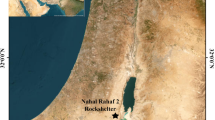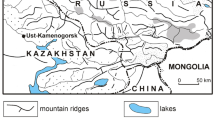Abstract
The cave of Saint-Marcel is known for its extensive network (64 km of galleries) and its history of human occupation (Middle Palaeolithic and Neolithic) in the entrance area. Close observation of the main network reveals areas with high concentrations of broken speleothems, which are usually attributed to the first tourist visits of the nineteenth century. However, archaeo-geomorphological mapping of the broken speleothems, many of which are lying on the floor and sealed by stalagmite regrowth or crust, indicates intentional organisation of the underground space into speleothem supply zones and zones in which the speleothems were used to build structures. Age estimates of the stalagmite seals on these human-made structures suggest that the structures were a result of human activity that occurred between the end of the Upper Palaeolithic and the European Mesolithic. These age estimates radically change the way we look at the broken speleothems in the cave of Saint-Marcel and the structures associated with them. They bring to light the engagement of past human communities with the deep underground environment, at more than 1.5 km from the cave entrance, which can only be accessed by crossing obstacles (pits) that, today, are considered as difficult to be crossed. Our findings and ongoing research stress the unequivocal archaeological significance of the cave.














Similar content being viewed by others
Data Availability
Datasets generated during the current study are available from the corresponding author on reasonable request.
References
Ambert, P., Simone, S., Colomer, A., & Galant, P. (2004). Cesseras – Grotte d'Aldène » Note of archaeological project, ADLFI. Archéologie de la France - Occitanie, mis en ligne le 01 mars 2004 : http://journals.openedition.org/adlfi/11626; https://doi.org/10.4000/adlfi.11626
Arias, P., & Ontañon, R. (2020). La Garma: un sitio exceptional, una metodologia diferente. Actualidad de la Investigacion Arqueologica en Espana (2018-2019): Conferencias Impartidas en el Museo Arqueológico Nacional, 1, 45–64.
Bannay, J. (2019). Les spéléothèmes cassés et fragmentés de la grotte de Saint-Marcel-d’Ardèche: Hypothèses et clès de lecture (p. 63). Université Savoie Mont Blanc.
Bégouën, R., Fritz, C., Tosello, G., Clottes, J., Faist, F., Pastoors, A., Lacombe, S., & Fosse, P. (2007). Les Magdaléniens modelaient aussi l’argile. Les Dossiers d’archéologie, 324, 30–37.
Bégouën, R., Fritz, C., Tosello, G., Clottes, J., Pastoors, A., & Faist, F. (2009). Le sanctuaire secret des bisons : Il y a 14 000 ans, l’art et la vie des Magdaléniens dans la caverne du Tuc d’Audoubert (p. 416). Somology.
Burnet, H. (2022). Étude anthropo-géomorphologique du secteur des Colonnes – Grotte de Saint-Marcel-d’Ardèche (p. 82). Université Savoie Mont Blanc.
Cheng, H., Lawrence, E. R., Shen, C.-C., Polyak, V. J., Asmerom, Y., Woodhead, J. D., Hellstrom, J., Wang, Y., Kong, X., Spötl, C., Wang, X., & Calvin, A. E. (2013). Improvements in 230Th dating, 230Th and 234U half-life values, and U-Th isotopic measurements by multi-collector inductively coupled plasma mass spectrometry. Earth and Planetary Science Letters, 371–372, 82–91.
Clottes, J., & Simonnet, R. (1984). Le réseau René Clastres –Atlas archéologique de la France - L’art des cavernes (coord. Baudry, M.-T. ) (pp. 424–427). Paris: Imprimerie nationale.
d’Aligny, P. (1879). La vallée de l’Ardèche de Vallon à Saint-Martin- d’Ardèche. Annuaire du CAF, 6ème année, 370–391.
Dachary, M., Plassard, F., & Valladas, H. (2016). Rouffignac cave (Dordogne, France): A source of raw material exploited in the Mesolithic. PALEO, 27, 122–148. https://doi.org/10.4000/paleo.3202
David, B., Delannoy, J.-J., Urwin, C., Fresløv, J., & Mullett, R. (2021). Engaging and designing place: Furnishings and the architecture of archaeological sites in aboriginal Australia. In I.J. McNiven & B. David (Eds.), The Oxford handbook of the archaeology of indigenous Australia and New Guinea. Oxford University Press (2024; online edn, Oxford Academic, 10 Feb. 2021), 473–494. https://doi.org/10.1093/oxfordhb/9780190095611.013.16
David, B., Delannoy, J.-J., & Birkett-Rees, J. (2024). Mobile landscapes and their enduring places. Elements in Current Archaeological Tools and Techniques. Cambridge: Cambridge University Press. https://doi.org/10.1017/9781009181594
de Valgorge, O. (1946). Souvenirs de l’Ardèche. Tome second (p. 31). Paris: Paulin Editions.
Delannoy, J.-J., Geneste, J.-M., Jaillet, S., Boche, E., & Sadier, B. (2012). Les aménagements et structures anthropiques de la grotte Chauvet-Pont-d’Arc: apport d’une approche intégrative géomorpho-archéologique. Collection EDYTEM, Cahiers de Géographie, 13, 43–62. https://doi.org/10.3406/edyte.2012.1204. Karsts, Paysages et Préhistoire.
Delannoy, J.-J., David, B., Geneste, J.-M., Katherine, M., Barker, B., Whear, R.-L., & Gunn, R.-G. (2013). The social construction of caves and rockshelters: Chauvet cave (France) and Nawarla Gabarnmang (Australia). Antiquity, 87, 12–29. https://doi.org/10.1017/S0003598X00048596
Delannoy, J.-J., David, B., Fresløv, J., Mullett, R., Gunaikurnai Land and Waters Aboriginal Corporation, Green, H., Berthet, J., Petchey, F., Arnold, L.-J., Wood, R., McDowell, M., Crouch, J., Mialanes, J., Ash, J., & Wong, V.-N.-L. (2020). Geomorphological context and formation history of Cloggs Cave: What was the cave like when people inhabited it? Journal of Archaeological Science: Reports, 33, 34. https://doi.org/10.1016/j.jasrep.2020.102461
Delannoy, J.-J., & Geneste, J.-M. (2020). Monographie de la grotte Chauvet-Pont-d’Arc, Volume 1: Atlas. Collection: Documents d’archéologie française, Edition de la Maison des Sciences de l’Homme (p. 384). Paris. https://doi.org/10.4000/books.editionsmsh.49690
Gilles, R. (1986). La grotte de Saint Marcel. Ardèche Archéologie, 3, 1–5.
Gilli, E., & Delange, P. (2000). Utilisation des spéléothèmes comme indicateurs de néotectonique ou de paléosismicité. Revue d’Analyse Spatiale, N° spécial 2001 (pp. 1–10). Université de Nice.
Jaillet, S., Delannoy, J.-J., Monney, J., & Sadier, B. (2017). 3D modelling in rock art research terrestrial laser scanning, photogrammetry, and the time factor. In B. David & I. J. McNiven (Eds.), The Oxford handbook of the archaeology and anthropology of rock art (pp. 811–832). Oxford handbook.
Jaubert, J., Verheyden, S., Genty, D., Soulier, M., Cheng, H., Blamart, D., Burlet, C., Camus, H., Delaby, S., Deldicque, D., Edwards, R.-L., Ferrier, C., Lacrampe-Cuyaubère, F., Lévêque, F., Maksud, F., Mora, P., Muth, X., Régnier, E., Rouzaud, J.-N., & Santos, F. (2016). Early Neanderthal constructions deep in Bruniquel cave in southwestern France. Nature, 534, 111–114. https://doi.org/10.1038/nature18291
Lacave, C., Koller, M. G., & Egozcue, J. J. (2004). What can be concluded about seismic history from broken and unbroken speleothems? Journal of Earthquake Engineering, 8(3), 431–455.
Lacave, C., Koller, M., & Levret, A. (1999). Measurement of natural frequencies and damping of speleothems. Proceedings of the 12th World Conference on Earthquake Engineering, Auckland, New Zealand, 18p.
Lacave, C., Sadier, B., Delannoy, J. J., Nehme, C., & Egozcue, J. J. (2012). The use of speleothems to better constrain long return period seismic hazard in Lebanon. Proceedings of the 15th World Conference on Earthquake Engineering. (Vol. 354). Lisboa, Portugal: Paper.
Lateur, N., Moncel, M.-H., Mocochain, L., & Fernandes, P. (2023). Fréquentations des réseaux karstiques profonds par Néanderthal. Nouveaux exemples à la grotte de Saint-Marcel (Ardèche, France). Comptes Rendus PALEVOL, 22, 265–277. https://doi.org/10.5852/cr-palevol2023v22a15
Martel, E. A. (1888). Les Cévennes et la région des Causses (Lozère, Aveyron, Hérault, Gard, Ardèche) (8th ed., p. 408). Paris: Edition Ch. Delagrave.
Moncel, M.-H. (1998). Les niveaux moustériens de la grotte de Saint-Marcel d’Ardèche (Ardèche, France). Fouilles Réné Gilles. Reconnaissance de niveaux à débitage discoïde dans la vallée du Rhône. Bulletin de la Société Préhistorique Française, 95(2), 141–171. https://doi.org/10.3406/bspf.1998.10765
Monney, J., Jaillet, S. (2019). Phases de fréquentations humaines, ornementation pariétale et processus naturels: mise en place d’un cadre chronologique. Karstologia, 77, 49–62. https://hal.science/hal-01957634
Ontañon, R. (2003). Sols et structures d’habitat au Paléolithique supérieur, nouvelles données depuis les Cantabres: La Galerie Inférieure de La Garma (Cantabrie, Espagne). L’Anthropologie, 107, 333–363. https://doi.org/10.1016/S0003-5521(03)00037-2
Pons-Branchu, E., Hamelin, B., Brulhet, J., & Bruxelles, L. (2004). Speleothem rupture in karst: Tectonic or climatic origin? U-Th dating of rupture events in Salamandre Cave (Gard, South-Eastern France). Bulletin de la Société Géologique de France, 175(5), 473–479.
Pons-Branchu, E., Douville, E., Roy-Barman, M., Dumont, E., Branchu, E., Thil, F., Frank, N., Bordier, L., & Borst, W. (2014). A geochemical perspective on Parisian urban history based on U-Th dating, laminae counting and yttrium and REE concentrations of recent carbonates in underground aqueducts. Quaternary Geochronology, 24, 44–53.
Rossoni-Notter, E., Notter, O., Simone, S., & Simon, P. (2016). Acheulean technical behaviors in Aldène cave (Cesseras, Hérault, France). Quaternary International, 409, 149–173. https://doi.org/10.1016/j.quaint.2015.11.016
Rouzaud, F. (1997). – La paléospéléologie ou l’approche globale des documents anthropiques et paléontologiques conservés dans le karst profond. Quaternaire, 8(2–3), 257–265.
Samartin, S., Heiri, O., Joos, F., Renssen, H., Franke, J., Brönnimann, S., & Tinner, W. (2017). Warm Mediterranean mid-Holocene summers inferred from fossil midge assemblages. Nature Geosciences, 10, 207–212. https://doi.org/10.1038/ngeo2891
Szmidt, C., Moncel, M. H., & Daujeard, C. (2010). New data on the Late Mousterian in Mediterranean France: First radiocarbon (AMS) dates at Saint-Marcel Cave (Ardèche). Comptes Rendu Palevol, 9, 185–199.
Urwin, C., David, B., Delannoy, J.-J., Bell, J-A., & Geneste, J.-M. (2022). Aboriginal monumental stone-working in Northern Australia during the Pleistocene. In L. Laporte & J.M. Large (Eds.), Megaliths from the world, (pp. 241–255) Archaeopress.
Verheyden, S., Jaubert, J., Genty, D., & Soulier, M. (2017). Grotte de Bruniquel (Tarn-et-Garonne): éléments de datation complémentaires. Karstologia, 70, 1–14.
Acknowledgements
The authors would like to thank the municipality of Saint-Marcel and all the staff working at the cave for their hospitality, for placing their trust in us, and for facilitating our research and that of the Master’s students. The research conducted by Master’s students Juliette Bannay, Elodie Lecornu, France Dubich, Hugo Burnet, Juliette Aronovitz, and Mathilde Bertin laid solid foundations for the work presented in this article. Many thanks to Judicaël Arnaud and the Comité Départemental de Spéléologie (CDS) Ardèche for their careful route marking that preserved the fieldwork that was in progress and, above all, the human-made modifications linked to different generations of cave visitors. Our thanks to the Sciences du Climat et Environnement (LCSE) laboratory and the Panoply platform for paying special attention to the dating of the calcite samples and to the Environnements, Dynamiques et Territoire de la montagne (EDYTEM) laboratory for the laser scanning and coring in the field. Without these contributions, this work would not have been possible.
Funding
The funding obtained was provided by (i) the EDYTEM laboratory (University of Savoie Mont Blanc) for the fieldwork and lasergrammetric and cartographic surveys and (ii) the LSCE laboratory (Panoply platform) for the U/Th isotope analyses.
Author information
Authors and Affiliations
Contributions
All the authors participated in conducting the research presented in this article and in the writing of the article. J.-J.D., J.K. and S.J. wrote the body of the article (Sections. 1, 2, 4 and 5) and designed Figures 1-8 and 11-14.
E.P.-B., A.D. and S.V. carried out the U/Th processing and analysis, wrote the second part of the results section (dating) and produced Figs. 9 and 10 as well as Table 2.
D.D. helped with the research at the Saint Marcel cave site. All the authors read and contributed to the final draft of the article.
Corresponding author
Ethics declarations
Competing Interests
The authors declare no competing interests.
Additional information
Publisher's Note
Springer Nature remains neutral with regard to jurisdictional claims in published maps and institutional affiliations.
Rights and permissions
Springer Nature or its licensor (e.g. a society or other partner) holds exclusive rights to this article under a publishing agreement with the author(s) or other rightsholder(s); author self-archiving of the accepted manuscript version of this article is solely governed by the terms of such publishing agreement and applicable law.
About this article
Cite this article
Delannoy, JJ., Kemper, J., Jaillet, S. et al. Investigating Human Activities in Caves Through the Study of Broken Stalagmite Structures: The Case of the Saint-Marcel Cave (France) During the Early Holocene. J Archaeol Method Theory (2024). https://doi.org/10.1007/s10816-024-09649-6
Accepted:
Published:
DOI: https://doi.org/10.1007/s10816-024-09649-6




